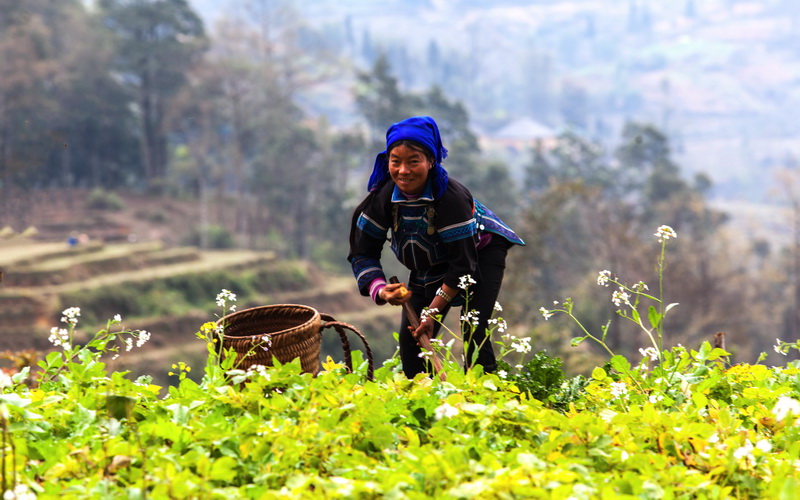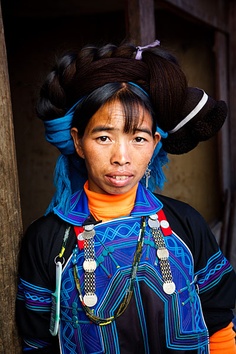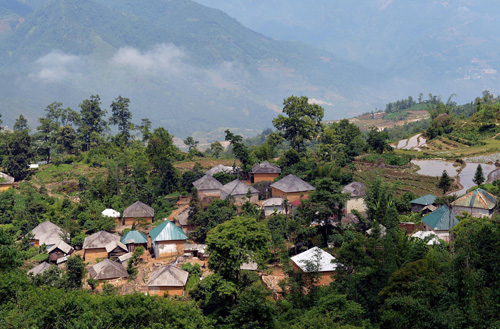Tailor Made Holidays with our travel experts
We'll do our best to call you within 48h

Name of ethnic group: Ha Nhi (U Ni and Xa U Ni).
Population: 17,535 people (Year 1999).
Locality: Lai Chau and Lao Cai provinces.
Customs and habits
The Ha Nhi have adopted a sedentary lifestyle. Every year during Tet (New Year's Day), the people of the same lineage get together to listen to an elderly man speak about their ancestors. Young men and women are free to choose their partners. Each marriage goes through two stages. In the first stage, young men and women become husband and wife and take the family name of the husband. The second stage is organized when the couple becomes established and has a child. When a person dies, the bedroom partition of the deceased is dismantled, as well as the altar for their ancestors. The dead body is placed on a bed in the kitchen and a good hour and day must be chosen for the burial ceremony.
Culture
The Ha Nhi language belongs to the Tibet-Burman Group. The Ha Nhi possess many ancient tales and long versed stories. Young men and women enjoy dancing. Young couples express their love by playing leaf panpipes, lip organs and a vertical flute. Young girls like to play "am ba" and "met du" and young boys like to play "la khu". There are many types of songs in Ha Nhi society such as lullabies, duet songs, wedding songs, mourning songs, songs reserved for new houses, receiving guests, and welcoming Tet holidays.
Costumes
The women of Lai Chau wear a decorated dress in various raw colours. This is different from the dress of the Lao Cai women which is only indigo in colour.
Economy
The Ha Nhi a slash-and-burn method of cultivation and plant on terraced fields. Animal husbandry is well developed as well as weaving cloth and basketry articles.
Ha Nhi Ethnic People's House


.jpg)
In Bat Xat, Lao Cai province Ha Nhi house has a system architecture that is relatively unique. According to the opinion of the Ha Nhi, the house always leans towards the hill and look toward the valley because of the full wealth in such house, if that turned into the direction of the slot, it will not be good for homeowners. Ha Nhi house still maintained soiled foundation architecture including 4 roofs, the frame is created by a column system, the crossbar and assisted by a system of 4,5m long, 4m high walls. The house has only one door and a few vents to get light.
In the hallway of the house they set up the beds for guests and their un-marriage son. On the rightside of the middle wall the stove is set adjacently to it, on the left putting furnitures, the middle space using for eating when the guests come. On the leftside of the wall is the bedroom of the owner, between two areas, the height of 50cm wooden floor used for welcoming guests and having dinner. Adjacent to the back wall setting bed for old people (father or mother), at the corner which is adjacent to bride'chamber is altar of their ancestors.
Giay Group Ethnic
Name of ethnic group: Giay (Nhang, Dang, Pau Thin, Pu Na, Cui Chu and Xa).
Population: 49,098 people (Year 1999).
Locality: Concentrated in Bat Xat, Bao Thang and Muong Khuong districts (Lao Cai Province); Yen Minh and Dong Van districts (Ha Giang Province); Phong Tho and Muong Te districts (Lai Chau Province); and Cao Bang Province.
Customs and habits
The Giay worship not only their ancestors but also the genies of the heaven, the earth, and the kitchen, including the Goddess of Childbirth. The Giay villages are very crowded, containing hundreds of households. Houses are built on stilts or on level ground. The central bay of the hoserves as a place for receiving guests and for the ancestor altar. Patriarchal customs rule Giay families. The children take on the family name of their father. The family of a young man usually seeks a marriage for their son. During pregnancy, Giay women must obey certain taboos and a special altar is up for the delivery.
Culture
Giay language belongs to the Tay-Thai Group. The cultural heritage of the Giay is rich including many ancient tales, poems, proverbs, puzzles, and alternating songs.
Costumes
Men wear trousers, short vests and wind a turban around their heads. Women wear a five-paneled vest open at the side, which buttons under the right armpit, and trousers. They wear their hair wound around their head or wind it in a turban.
Economy
The Giay practice rice cultivation in submerged fields and rear animals to provides for additional income. The Giay also rear plenty of horses as pack animals and for transport.